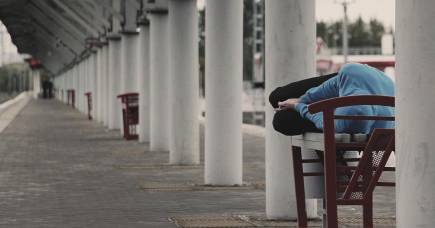
Breaking the family chain of joblessness
But what has been unclear until now is the long-term impact of dual-parent joblessness on a child’s life chances, write Associate Professor Irma Mooi-Reci, Dr Matthew Curry and Professor Mark Wooden
In fact, there’s only a limited understanding, both in Australia and elsewhere, of the challenges these children face as they grow up.
Our new research, published by the Melbourne Institute, investigates the channels through which social and economic disadvantage is transmitted from Australian parents to their children, and whether this disadvantage can be reduced.
‘Limited understanding of the challenges faced’
We found that more than 40 per cent of young Australians experience joblessness between the ages of 19 and 32 if they have had jobless parents as a child.Further, children living in jobless households experience a 12 per cent increase in the probability of becoming jobless as adults.

The grim cycle of homelessness and unemployment
Read more
But the impact doesn’t stop there.
These children also experience a significant delay in their transition from school into work, and face penalties of up to 10 per cent in their hourly wages.
Challenges for the future
Our four-year, Australian Research Council-funded project aimed to address two key questions: Does parental joblessness damage a child’s future employment outcomes? And can good policy help to break intergenerational cycles of joblessness?
Using 17 years of longitudinal data from the Household, Income and Labour Dynamics in Australia (HILDA) Survey, we traced both parents’ employment histories during the pre-adult life of their children.
 Economic disadvantage can be transmitted from Australian parents to their children. Picture: Getty Images
Economic disadvantage can be transmitted from Australian parents to their children. Picture: Getty Images
Next, we examined how overlapping spells of parental joblessness can impact on a range of children’s outcomes including the likelihood of joblessness, the transition from school to work and their subsequent wages.
Exposure to dual-parent joblessness creates serious challenges for children’s futures.
These relationships are significantly stronger when both parents experience joblessness at the same time. However, the negative effects of parental joblessness can be mitigated, at least in part.

Taking a clear look at inequality
Read more
For example, children in households where jobless fathers did more work around the house actually experienced higher chances of employment.
A university degree also helped reduce wage penalties among young people whose parents were jobless when they were growing up.
Intergenerational impact
The amount of time that children are exposed to dual-parent joblessness can make it even harder to escape future joblessness.
One explanation for this relates to reduced household income.
If parents have a reduced ability to provide children with enriched and stimulating learning environments or are unable to buy educational goods and services that enhance children’s education, it will be reflected in poor labour market outcomes.
 Children of jobless fathers who do more work around the house experienced higher chances of employment. Picture: Shutterstock
Children of jobless fathers who do more work around the house experienced higher chances of employment. Picture: Shutterstock
Another explanation relates to socialisation.
Children who see their mothers and fathers out of the labour force over an extended time may develop negative attitudes about the importance of work.
Consequently, these children could become discouraged and less engaged in education and training activities, and more detached from employment.

Who is left behind under the new child care subsidy?
Read more
Then there are other factors like the number of siblings in the household, a mother’s educational attainment and a child’s gender that can all help determine whether children follow their parents’ joblessness patterns once they reach adulthood.
How policy can adapt
Our research recommends four concrete ways to break the chain of intergenerational disadvantage.
The first is simple – increasing flexibility in the provision of childcare and parental leave. A key factor in maternal joblessness is often concerns about childcare.
Policy that includes steps like more generous child-care assistance and improved paid parental leave could potentially help both parents stay in employment – ultimately, improving their financial position and family wellbeing.
 A key factor in maternal joblessness is often concerns about childcare. Picture: Getty Images
A key factor in maternal joblessness is often concerns about childcare. Picture: Getty Images
Secondly, more generous family benefits and ‘top-ups’ like childcare tax credits and housing vouchers, could provide assistance to low-income jobless households and help reduce income inequality.
Our research shows that a one per cent increase in household disposable incomes reduces the intergenerational joblessness transmission by about three per cent.
This suggests that boosting the generosity of the welfare system could help alleviate persistent joblessness and reduce disadvantage.

Work or family?
Read more
Thirdly, our research shows that the intergenerational costs of joblessness are more nuanced for children who go on to obtain a university degree.
In addition to advancing their skills, a university education can help young people create valuable networks that, in turn, may lead to smoother transitions to work.
For other young people with a family history of joblessness, programs that target better links with potential employers could help prevent entrenched employment disadvantage.
Finally, we need to improve the skill development and training opportunities for young people.
‘Prevent children from experiencing a jobless future’
Facilitating a young person’s access to free, extra-curricular activities and training that can boost help their literacy skills and educational achievements may have life-long benefits.
Improving the financial capacity of jobless families isn’t the only equalising factor.
Boosting children’s educational achievements, smoothing transitions to work, encouraging fathers to engage domestically can help foster positive attitudes about productive labour and prevent children from experiencing a jobless future.
This article was first published on Pursuit. Read the original article.”
Banner: Shutterstock




